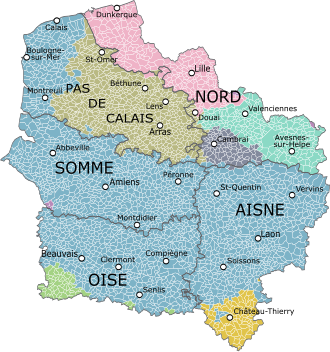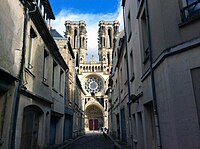|
Hauts-de-France
Hauts-de-France (French: [o d(ə) fʁɑ̃s] ⓘ; Picard: Heuts d'Franche; lit. 'Heights of France'), also referred to in English as Upper France,[3] is the northernmost region of France, created by the territorial reform of French regions in 2014, from a merger of Nord-Pas-de-Calais and Picardy. Its prefecture is Lille. The new region came into existence on 1 January 2016, after regional elections in December 2015.[4] The Conseil d'État approved Hauts-de-France as the name of the region on 28 September 2016, effective the following 30 September.[5][6] With 6,009,976 inhabitants as of 1 January 2015 and a population density of 189 inhabitants per km2, it is the third most populous region in France and the second-most densely populated in metropolitan France after its southern neighbour Île-de-France. It is bordered by Belgium to the north and by the United Kingdom to the northwest through the Channel Tunnel, a railway tunnel crossing the English Channel. The region is a blend mixture of French and (southern-) Dutch cultures. ToponymyThe region's interim name Nord-Pas-de-Calais-Picardie was a hyphenated placename, created by hyphenating the merged regions' names—Nord-Pas-de-Calais and Picardie—in alphabetical order.[7] On 14 March 2016, well ahead of the 1 July deadline, the regional council decided on Hauts-de-France as the region's permanent name.[5][7] The provisional name of the region was retired on 30 September 2016, when the new name of the region, Hauts-de-France, took effect.[6] GeographyThe region covers an area of more than 31,813 km2 (12,283 sq mi). It borders Belgium (Flanders and Wallonia) to the northeast, the North Sea to the north, the English Channel to the west, as well as the French regions of Grand Est to the east-southeast, Île-de-France to the south, and Normandy to the west-southwest. It is connected to the United Kingdom (England) via the Channel Tunnel.  DepartmentsHauts-de-France comprises five departments: Aisne, Nord, Oise, Pas-de-Calais, and Somme. Major communities
EconomyThe gross domestic product (GDP) of the region was 161.7 billion euros in 2018, accounting for 6.9% of French economic output. GDP per capita adjusted for purchasing power was 24,200 euros or 80% of the EU27 average in the same year. The GDP per employee was 101% of the EU average.[8] Linen weavingThe region was a pivotal centre of mulquinerie. See also
References
External linksWikivoyage has a travel guide for Hauts-de-France.
|
||||||||||||||||||||||||||||||||||||||||||||||||||







